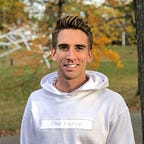Roll To Record.
Clients expect the highest level of production quality for multi-camera interviews with high-profile guests. It’s important to have the right experience, equipment, and camera configurations to streamline the entire multi-camera production, from set-up and recording to delivery. Many projects also have budget or time constraints that can add additional post-production challenges.
At a recent shoot, Dan Martland and I (Stephen Greaves) put our skills to work and are proud to show the results.
The commission was to shoot and technically produce several multi-camera, sit-down interviews for “The Heat”, a live 30-minute show (on this occasion, an “as-live show”) airing on CGTN (formerly CCTV).
One key to achieving the highest level of production quality comes down to the videographers’ equipment. We both own Sony PMW-F5s and mostly operate with Canon Cn7 lenses. For this production, we gave the interview shots as much depth as possible. Knowing the setting for the interviews in advance helped us decide what lenses to use. Ultimately, we shot this production with fast prime and zoom lenses. Shooting wide open with fast primes achieved that shallow depth of field look.
Of course, production goes beyond the equipment, so we supply and source other aspects, including props, sound, lighting, crew, and make-up. For example, we modified the old-style wooden wall panels to create a more modern looking environment — consistent with the show’s style and tone — by using props and specialized textured color lighting.
A major challenge on this project was the timeline. Like many jobs we do, this client requested a very quick turnaround. Immediately after filming ended, the footage had to be delivered from New York to Washington D.C., edited, and prepared for air. Typically, we would shoot a production like this in slog2 or slog3 either in 4k or HD. However, due to the tight turnaround, we encountered an issue similar to many clients with limited time or budget: expectations of a high-quality product but insufficient resources for extensive post-production editing and/or color grading.
Fortunately, we’re prepared for such scenarios. Over the past year, we’ve been working with leading industry specialists to configure our cameras to produce images that blend contract with a natural look. After months of work and refinement, our cameras produce images that meet the high standards of clients, viewers, and us.
Our specialized color profiles can save time and money for fast turn around projects — or even live productions — where the image has to look perfect straight after shooting.
We utilized a number of other techniques to achieve a high-quality product while minimizing client costs. For example, although we use a minimum of four cameras for shoots like this one in order to maximize the number of angles, not all are manually operated throughout filming. We manage this by pairing cameras with supports. This includes using electronic sliders and dollies and streaming all camera footage to a dedicated recording/monitor.
The main benefit of using an electronic slider is that it takes human error out of achieving subtle repetitive camera movements for hours on end. We have chosen to use the Rhino Motorized Slider with Arc because it’s fast and easy to set up and adds a “wow factor” to any production. It enables repetition of a steady, slow movement, moving the camera along a track and arcing the camera body to and from pre-programmed points. This allows the director or editor to choose this camera angle at any time during the movement, knowing that it will always be focused and framed on the host and guest.
To speed up the pre-editing process, all of our camera angles are recorded by the Convergent Design Odyssey7Q+. This provides a quad-split viewer for the client and syncs all camera footage, assigning the same timecode to each camera feed. As all camera professionals will know, synced timecodes are extremely vital in achieving a smooth and fast edit. The Odyssey7Q+ has the added capacity to live switch using the “Apollo” feature if the client requires a live-to-air or switched product.
Every project is different, so the capacity to adapt and efficiently leverage other resources as needed is critical. Dan and I often collaborate with highly skilled and experienced freelancers who specialize in the broadcast and production industry, including sound recordists, runners, make-up artists, autocue operators, editors, and many other production crew positions.
One thing that doesn’t vary however, is that every client has quality expectations, a timeline, and a budget. We’ve consistently demonstrated, including through this CGTN project, our ability to creatively and professionally deliver a top quality production within budget and on-time. We look forward to future opportunities and welcome questions and project inquiries.
We’re both New York City-based but are very comfortable with domestic and international travel. We can be reached through our contact info below, which also links to other examples of our work.
Stephen Greaves. Email: stephen@mixel.media Website Twitter Linkedin
Dan Martland. Email: dantv@mac.com Website Twitter Instagram Linkedin
